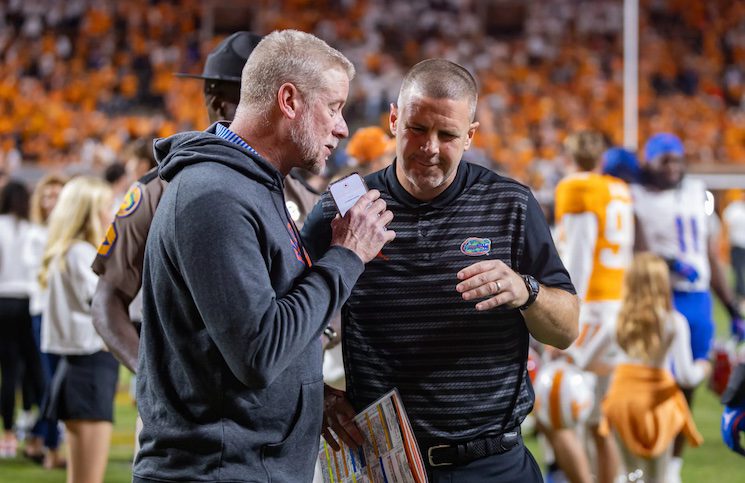
In Jeremy Pruitt’s first year as Tennessee’s head coach, the Vols showed some improvement on the field compared to last season. That improvement wasn’t enough to get Tennessee to a bowl game, but there were some definite positives from Pruitt’s first season at the helm.
Improving from UT’s worst season in program history shouldn’t be hard, and that’s exactly what the Vols did this year. Still, the improvement was only slight compared to last season.
The Vols won one more game overall this year than last year, and they got two more SEC victories than last season. But their improvement goes beyond just the team’s win/loss record.
Here’s a look at how the Vols’ offense improved from 2017 to 2018:
Yards Per Game: +34.4 (325.5 in 2018, 291.1 in 2017)
Points Per Game: +3 (22.8 in 2018, 19.8 in 2017)
Rushing Yards Per Game: +11.7 (128.1 in 2017, 117.4 in 2017)
Passing Yards Per Game: +22.7 (196.4 in 2018, 173.7 in 2017)
Yards Per Play: +0.69 (5.46 in 2018, 4.77 in 2017)
Total Plays: -16 (716 in 2018, 732 in 2017)
Third Down Conversion: +7.5% (38.2% in 2018, 30.7 in 2017)
Red Zone Scoring: +8.2% (88.2% in 2018, 80% in 2017)
Big Play Percentage: +2.07% (7.26% in 2018, 5.19% in 2017)
Time of Possession: +57 seconds (29:10 in 2018, 28:13 in 2017)
Giveaways: -2 (16 in 2018, 18 in 2017)
Sacks Allowed: -12 (23 in 2018, 35 in 2017)
TFLs Allowed: +3 (92 in 2018, 89 in 2017)
The biggest difference in Tennessee’s offense from last year to this year was their ability to create big plays. While the Vols still weren’t an explosive offense by any means, they did increase their “big play percentage” (plays of 20 or more yards) by over two percent. That also led to over half a yard improvement for the Vols’ yards per play and over 30 yards of improvement in their total yards per game.
Interestingly, Tennessee’s total number of offensive plays actually dropped by 16 plays compared to last season. The Vols’ 716 offensive plays this season were the lowest they totaled in a single season since 2004. Tennessee tried to be more of a ball control offense this year to help out their thin defense, and they did an okay job of that. The Vols’ average time of possession on offense was up almost a full minute compared to last year’s offense. Tennessee averaged over 30 minutes of possession for most of the year, but that number dipped in UT’s last two games.
Tennessee’s offense still wasn’t as efficient as they would’ve liked to have been, but they improved their third down conversion percentage and red zone scoring a pretty good amount from last season. They also upped their scoring total by a field goal, though they still didn’t put up enough points consistently.
Last year, Tennessee’s offensive line was really bad. This year, they were worse, though the stats don’t necessarily reflect that as much as you might think. UT gave up 12 fewer sacks this year compared to last year, but some of that was mitigated because Tennessee used quick passes a lot of times so the line didn’t have to protect for very long. They did, however, give up three more tackles for loss than last season.
Now, here’s a look at how Tennessee defense improved from 2017 to 2018:
Yards Allowed Per Game: -35.5 (377.4 in 2018, 412.9 in 2017)
Points Allowed Per Game: -1.2 (27.9 in 2018, 29.1 in 2017)
Rushing Yards Allowed Per Game: -96.8 (154.5 in 2018, 251.3 in 2017)
Passing Yards Allowed Per Game: +61.2 (222.9 in 2018, 161.7 in 2017)
Yards Per Play Allowed: -0.27 (5.67 in 2018, 5.94 in 2017)
Total Opponent Plays: -35 (799 in 2018, 834 in 2017)
Opponent Third Down Conversions: -6.2% (39% in 2018, 45.2% in 2017)
Opponent Red Zone Scoring: +1.1% (91.1% in 2018, 90% in 2017)
Opponent Big Play Percentage: +0.02% (6.26% in 2018, 6.24% in 2017)
Opponent Time of Possession: -57 seconds (30:50 in 2018, 31:47 in 2017)
Takeaways: No Change (15 in 2018, 15 in 2017)
Sacks: +3 (25 in 2018, 22 in 2017)
TFLs: +7 (68 in 2018, 61 in 2017)
On defense, Tennessee saw massive improvement in their run defense. The Vols gave up almost 100 fewer yards per game on the ground this season compared to last year. But a lot of that difference was negated by the Vols’ inability to stop quality passing attacks. West Virginia, Auburn, Alabama, Missouri, and Vanderbilt all sliced UT’s defense through the air, and it resulted in Tennessee giving up over 60 more yards per game to opponents when they passed the ball.
Even with that, though, the Vols still gave up fewer yards and points per game to opponents than last season. But those improvements were still minimal.
The Vols held the ball longer on offense, which meant UT’s opponents didn’t get as many plays off this year. Tennessee’s opponents ran 35 fewer plays against them compared to last season, but opponents only averaged 0.27 fewer yards per play, and they’re “big play percentage” rose slightly by 0.02 percent. So Tennessee was still giving up big plays; they just didn’t allow opponents to have the ball as often.
Tennessee got better on third down as a team, and they picked up a few more sacks and tackles for loss on the season. But one of the more disappointing stats is that UT didn’t improve on their turnover total at all from last year. Tennessee had 15 takeaways in 2017 and had the same amount in 2018.
All in all, the Vols showed improvements in most areas this year when compared to last season. But most of those improvements weren’t all that drastic, and that was reflected both on the field and in Tennessee’s win/loss record.
Jeremy Pruitt’s first year as a head coach saw some steps in the right direction, but he’ll need his team to make a bigger leap next year if they want to continue down the right path.




